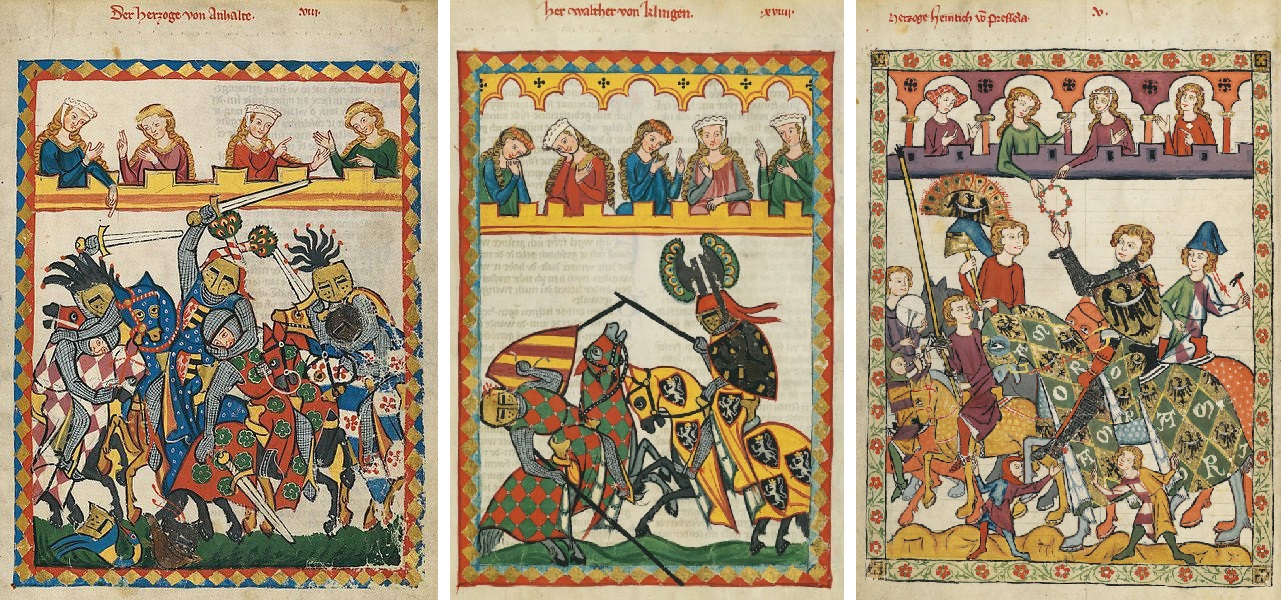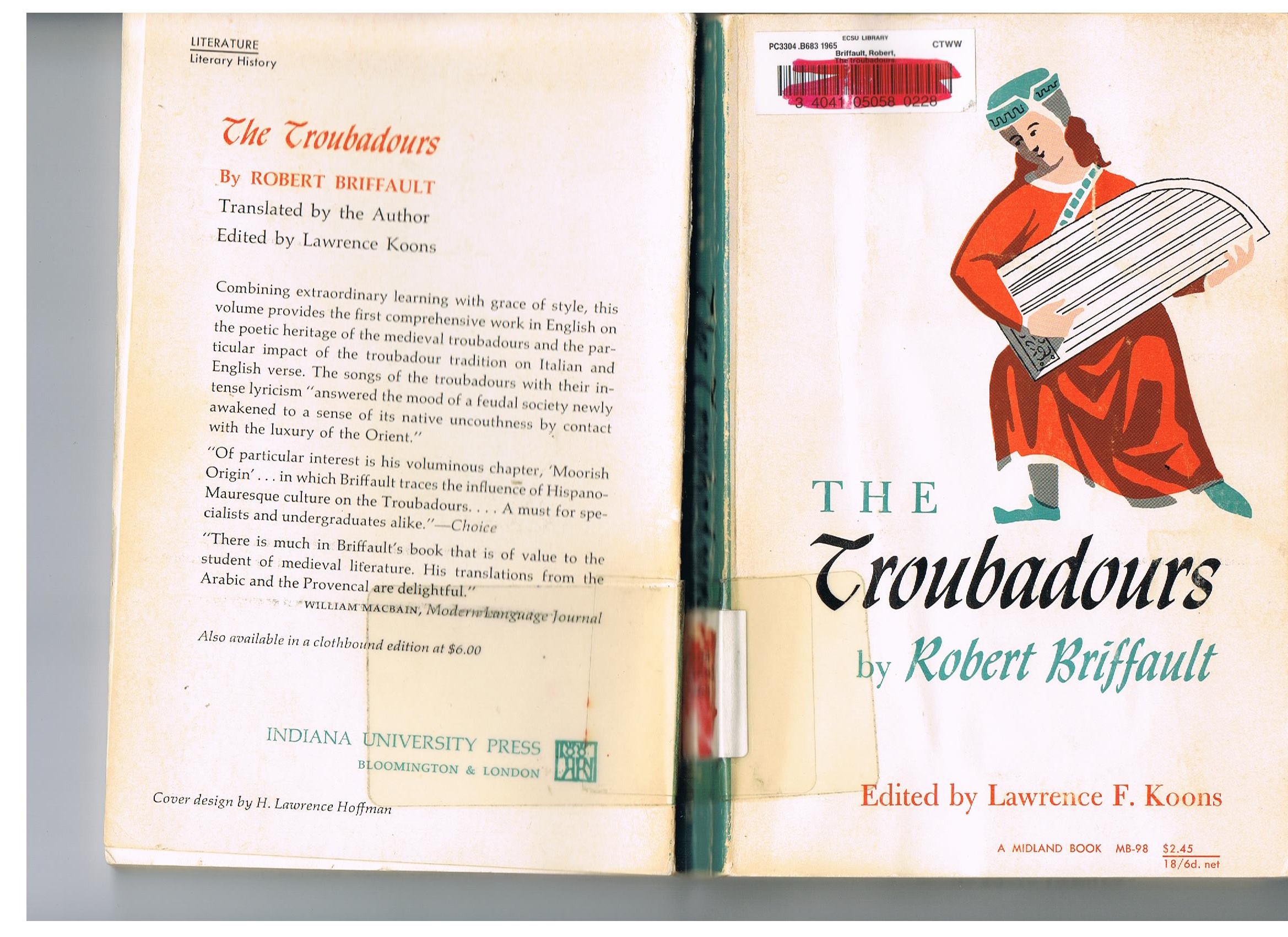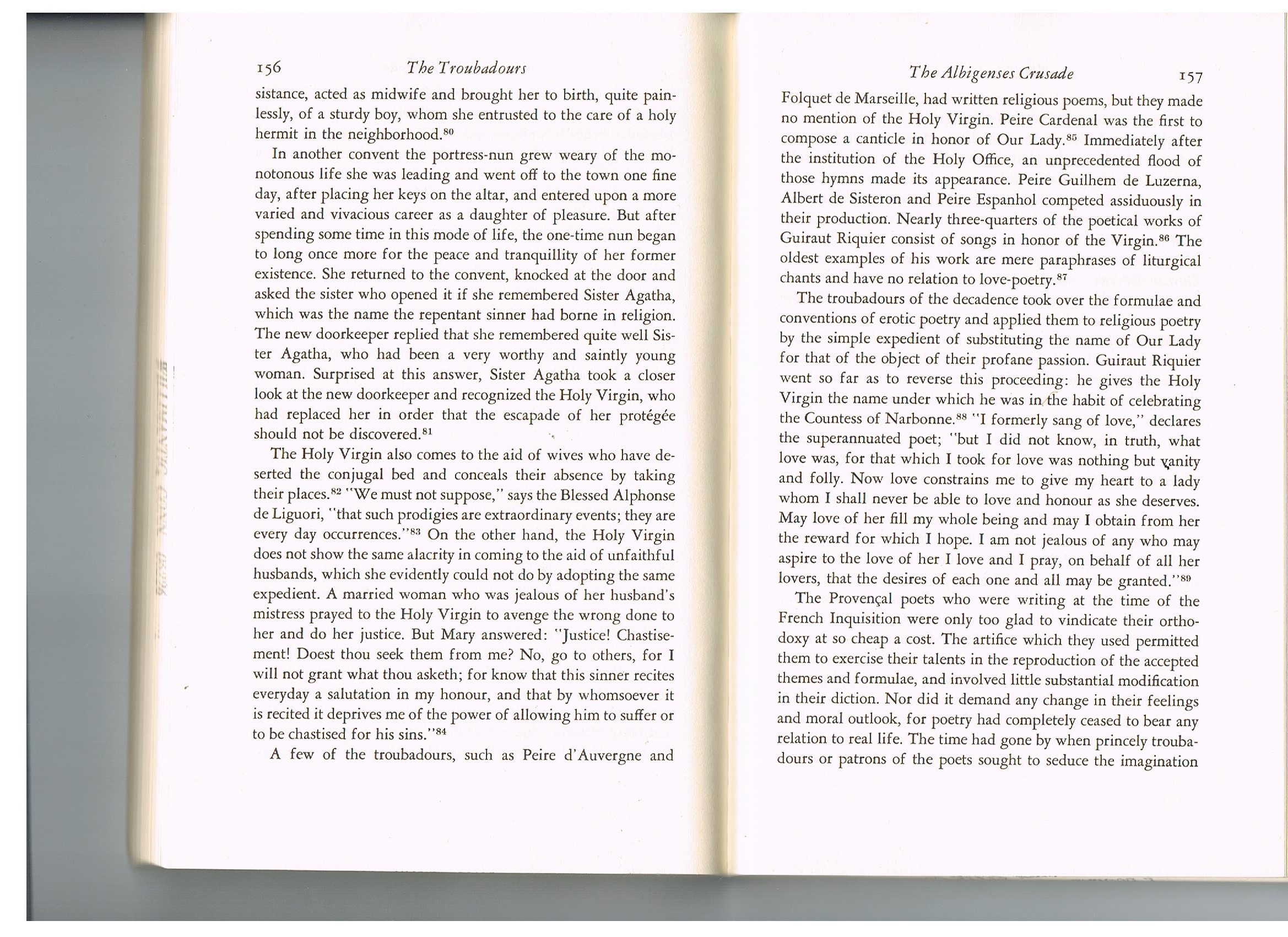The following is a video by Tom Golden discussing the gynocentric forces in society and how they impact men.
Month: January 2017
Courtship
Courtship is part of our everyday speech. We follow the rules of courtship, we enter into courtship, we follow the courtships of the rich and famous, and sometimes we end a courtship. While it may sound like a quaint antique of European language, the word still appears in our daily media headlines proving that the modern imagination remains in its thrall.
So what exactly is this thing we call courtship? To answer that we are going to have to dig into its history, and the best place to start is with the etymology itself:

The etymology starts with a reference to a courtier, whom Dictionary.com defines as “a person who seeks favor by flattery, charm, etc.” Next we read that the paying of attentions is from a man to a woman “with the intention of marriage” – there is no explicit requirement for a woman to do something for a man. The scenario given here is clearly one-sided in terms of who must make the effort, and who will be the recipient of that effort. Courtship is, in a word, gynocentric.
But just in case we have narrowed the definition of courtship to an anachronistic conception of it, let’s take a look at modern dictionaries to see whether they too paint a uni-directional picture of courting – ie. of men catering to women:
The Free Dictionary by Farlex:
Noun 1. Courting: a man’s courting of a woman; seeking the affections of a woman (usually with the hope of marriage); “It was a brief but intense courtship.”Vocabulary.com:
Noun 1. Courting: a man’s courting of a woman; seeking the affections of a woman (usually with the hope of marriage).
There we have two popular online dictionaries verifying the gendered expectation inherent to the term. Other dictionaries however have de-gendered the definition in line with the modern practice of denying gendered customs and behaviors, but this does little to change the phenomenal reality – practices which continue to be gendered despite the refusal to acknowledge them as such.
Studies of courtship have confirmed that men’s practice of demonstrating various kinds of attentions toward women amount to a gynocentric contract. Drs. Timothy Perper1 and Monica M. Moore2 have independently discovered, contrary to popular beliefs, that courtship is normally triggered and controlled by women and driven mainly by non-verbal behaviours to which men respond. That gynocentric pattern of power is supported by other theorists who specialize in the study of body language.3
For those unsure as to whether courtship remains a gendered expectation, the following advice by columnist James Michael Sama provides a modern example.
In many of my articles I refer to “courtship” or “courting women,” when discussing chivalry and romance… and why do I think we should work to keep it alive? Here are five reasons:
1. You’ll develop a stronger relationship.
It is traditionally so that the man in a new relationship will be the one who is courting a woman. As men, we are the pursuers, both naturally and societally. I have often heard men ask “what’s in it for me?” Well, first of all if you’re performing acts of kindness for the sake of a reward (see #3 in the definition above) then it is not true kindness.
Real kindness comes from the goodness of your heart without the want for reward but it should also be noted that courting a woman will bring two things into your life:
The type of woman with the maturity and dignity to only accept advances from a man who treats her with respect. The ability to therefore grow a stronger and longer lasting relationship with the woman in question..
2. You become better in all areas of life.
Courtship is (read: should be) a selfless act. It requires you to put in effort for another person’s enjoyment, learn about them and learn about yourself in the process. When committing one’s self to efforts such as these, one cannot help but to develop internally as well. We become more aware of the world around us, what people want and need in order to be happy, and how we can help give it to them.
3. You will gain her trust.
One of the biggest factors in relationships failing these days is lack of trust. Either lack of trust during the beginning stages, or even after commitment has been established.
If a man takes the time to court a woman, it requires him to build a foundation for the relationship. Relationships do not simply appear out of thin air. They take time, energy, and commitment to build, much like a house. But a relationship without this trust and friendship is like a house built on sand. It may look good from the outside, but it will have nothing to keep it standing when the weather gets rough.
If a woman has a clear view that you’re willing to build this foundation with her, it will limit her insecurities and help build her confidence in you.
4. You will intensify your intimacy.
Through the process of courtship, men and women tend to develop a stronger emotional connection than if they had simply jumped into a relationship or a “friends with benefits” scenario. What many people don’t realize is that a stronger emotional connection, especially for a woman, translates to a stronger physical connection.
5. You will find the right person for YOU.
The right type of person will appreciate small details, the kindness you exude to those around you, and the effort you put in specifically for them. Through the courtship process we learn if a woman (or man) is going to be appreciative of what we do for them and how they will respond.
If we jump into a relationship, as many do these days, we are left complaining about how they “changed” after a few months of being with them, and then breaking up. In reality, nobody changed at all – you simply learned who they truly are.
If we take the time to practice courtship, we will eliminate these surprises down the road and truly learn who we are building a relationship with at the proper time to do so : in the beginning.
Show someone your respect for yourself as well as for them, by keeping courtship alive.4
This example indicates that men are still expected to carry the lion’s share of courting labour for the new couple. Clear too is that this is not a mere animal reflex as some would suggest, which clouds the idiosyncratic culture customs which gave it form. We tend to confuse cultural concepts of courting with biological mating impulses of animals, when they are logically distinct motivations with the one having its center of gravity biological reflexes, and the other in rituals, customs and taboos of a given society.
The blue wren never learned about chivalry and courtly love in order to know how to build a nest, does not rely on cultural customs to know nest design. Men and women on the other hand learn much of their repertoire of courtship, going down on one knee, or expecting chivalric deference from men, from the cultural mores that grew up around them. And unlike the blue wren, a serious study of cultural history can snap us out of our unconsciousness and open us up to potential new models for building relationships – like ones based on mutual effort and respect as opposed to the one-way street of courtship.
References:
[1] Perper, T. (1985) Sex Signals: The Biology Of Love, Philadelphia, ISI Press.
[2] Moore, N (1985). “Nonverbal courtship patterns in women: contact and consequences”. Ethology and Sociobiology. 6: 237–247.
[3] Pease, A. and Pease, B. (2004) The Definitive Book Of Body Language, London: Orion Books.
[4] 5 Brilliant Reasons Men Should Stop Playing Hard To Get If They Want The Woman Of Their Dreams
Further reading:
[Study] The allure of chivalry
[Study] Courtly Love Today: Romance and Socialization in Interpersonal Scripts
Sporting tournaments: a gynocentric tradition?
A recent article by Doug Mortimer tells a story of a young man who went to a small town high school in the Texas Panhandle:
An avid tennis player, he went to the powers that be at his school and asked if he could form a tennis club. Sure, go ahead. Why not?
At first, things went well. Membership in the tennis club grew steadily. Then things went too well. Football players were dropping out in favor of the tennis club. So the powers that be changed their minds, and the tennis club was deep-sixed.
It is a curious paradox. In academic environments, where toxic masculinity is routinely excoriated, why is football, the ultimate contact sport – and arguably the most “toxic” sport – sacrosanct?
Musing on the story Mortimer goes on to conclude that what makes football different from other team sports, in least in terms of popular culture, is the belief that “it will make a man out of you”:
In days of old, one could come right out and say that; today it’s sub rosa. Other team sports, such as soccer, basketball, or baseball, are OK, but no one asserts they will make a man out of you. After all, even girls play soccer, basketball, and baseball (well, softball). But girls don’t play football!
Athletic competition goes back at least as far as the ancient Greeks, but organized sports leagues are a relatively new phenomenon in civilization. The sociobiological take on them is they provide an arena for a ritualized form of aggression. Think of tribal warfare without spears.
So how did boys become men before football was invented? Playing games was a leisure activity at best. You could go your entire life without ever playing any kind of sport and no one would question your manhood.
This story and Mortimer’s comments illustrate a fundamental contradiction at the heart of male-shaming, ie. the very things society shames men and boys for – in this case bone jarring football – are the very things that same society encourages. The double message for men and boys is never really resolved and they carry it like a lead weight.
Mortimer makes an important point here, that men in classical times didn’t behave in the same way. Which begs the question of where, when and especially why did this ritualized form of competition come about? Historian Johan Huizinga provides an interesting answer to these questions:
“The warlike sports of the Middle Ages differ from Greek athletics by being far less simple and natural. Pride, honour, love and art give additional stimulus to the competition itself. Overloaded with pomp and decoration, full of heroic fancy, they serve to express romantic needs too strong for mere literature to satisfy. The realities of court life or a military career offered too little opportunity for the fine make-belief of heroism and love, which rilled the soul. So they had to be acted. The staging of the tournament, therefore, had to be that of romance ; that is to say, the imaginary world of Arthur, where the fancy of a fairy-tale was enhanced by the sentimentality of courtly love.” [ https://gynocentrism.com/2014/12/10/the-dream-of-heroism-and-love-by-johan-huizinga/ ]
Based on Huizinga’s account it seems the modern sporting tournament was born first in France and referred to the joust, sword fighting and other chivalric games, all of which seem to have their origin in impressing women (who sat attentively in the stadiums) and for the gaining of women’s romantic attentions. Same thing today – beautiful women lining up to fuck sports heroes, and sportsmen/teams/clubs doing special deeds for the ladies, from wearing pink jerseys to raise money for breast cancer or raising awareness about domestic violence, and generally sucking up.
And of course we have feminists assisting sporting clubs in the drafting of ‘respecting women’ charters that result in a more general feminist ownership of club culture.
Just compare today’s woman-impressing sports with descriptions of same in the Middle Ages:
Above: Female audience attending a medieval tournament
‘Many knights, says our Armoric fabler, famous for feats of chivalry, were present, with apparel and arms of the same colour and fashion. They formed a species of diversion, in imitation of a fight on horseback, and the ladies being placed on the walls of the castles, darted amorous glances on the combatants. None of these ladies esteemed any knight worthy of her love unless he had given proof of his gallantry in three fevered encounters. Thus the valour of the men encouraged chastity in the women, and the attention of the women proved an incentive to the soldier’s bravery’ [ https://gynocentrism.com/2013/09/14/chivalry-for-love-1774/ ]
Or this one written in 1818:
The looks, the words, the sign of a lady, were accounted to- make knights at time of need perform double their usual deeds of strength and valour. At tournaments and in combats, the voices of the ladies were heard like those of the German females in former battles, calling on the knights to remember their fame, and exert themselves to the uttermost. “Think, gentle knights,” was their cry, “upon the wool of your breasts, the nerve of your arms, the love you cherish in your hearts, and do valiantly for ladies behold you.” The corresponding shouts of the combatants were, “Love of ladies! Death of warriors! On, valiant knights, for you fight under fair eyes? Where the honour or love of a lady was at stake, the fairest prize was held out to the victorious knight, and champion from every quarter were sure to hasten to combat in a cause so popular. [ https://gynocentrism.com/2013/09/17/the-spirit-of-chivalry-1818/ ]
You get the picture…
The sporting tournament (from french word – tourney) arose at precisely the same time as romantic chivalry and courtly love, a theme that continues today in the ubiquitous sporting tournament everywhere. With this in mind it becomes the task of today’s sports-minded men to decide just who they are playing the game for; for upper class women like in France? or for simple, natural fun like the Greeks? some other reason?….. the answer is your call.
See also: The role of ladies in the first sporting tournaments
About Adam Kostakis
Adam Kostakis is a mysterious Slavic revolutionary from the dark hinterlands, an arcane doctor of epistemetaphysiology, an accomplished violinist who plays tortuously difficult Tartini sonatas on his vintage Stradivarius and lives in a dark, baronial castle atop the basalt cliffs overlooking the Yakima River Canyon in eastern Washington state, USA. In addition, Adam Kostakis wears a monocle, clicks his heels like a Prussian junker, and carries a manly duelling scar across his left cheekbone. All-in-all, patriarchally considered, quite the deuce of a fellow!
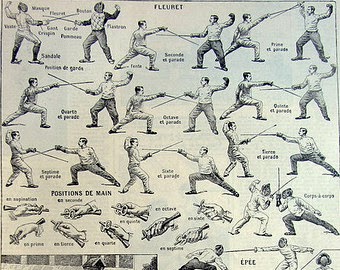
Kostakis’ Bio extracted from the original Gynocentrism Theory Lectures page on Google Blogger
Mariolatry and Gyneolatry
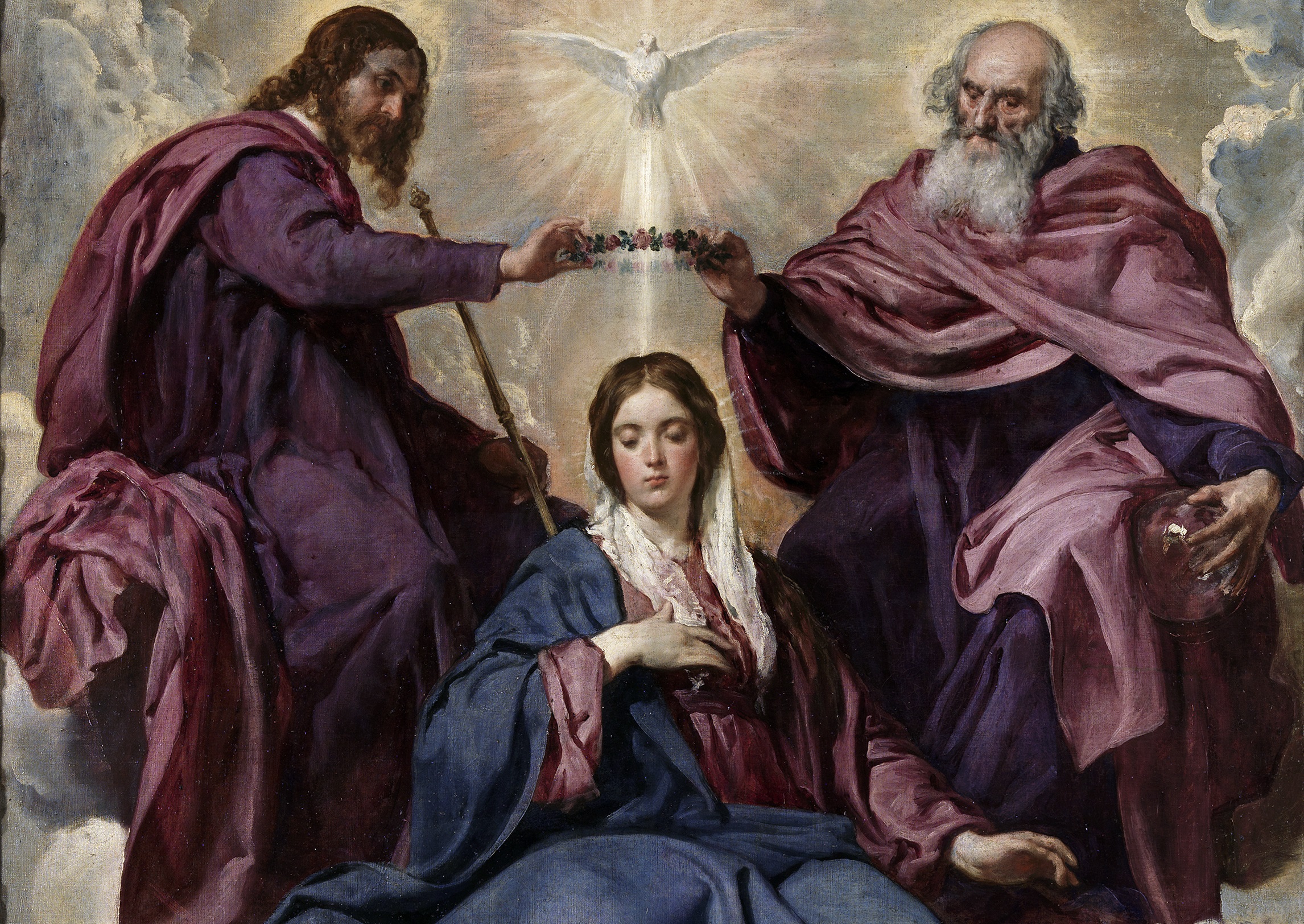
The following quotes (below) deal directly with lay Christian culture’s slow descent into gyneolatry as exemplified in many modern Churches. In a nutshell, the historical focus of lay Christendom evolved from the initial view that men and women are both born in original sin, to only men being so.
While official Church doctrine changed little in regard to original sin, with men and women being equal in their sinful inheritance, grassroots Christian attitudes toward gender began to evolve in the twelfth century. At this time there arose a new and heretical veneration of women as “counterparts of the Virgin Mary,” along with the rise of chivalry and courtly love, which had the effect of elevating women’s status and eclipsing the earlier emphasis on women inheriting original sin.
Like Mary, the notion of ‘woman’ as pure and holy became venerated among some laity.
After that change men continued to be viewed as sinners attempting to imitate Christ, whereas women were increasingly viewed, in popular heretical perspectives, as the Holy Virgin’s counterparts on earth, pure and perfect from the moment of birth, each a virgin with less focus on their need for redemption.
Said another way, after the Middle Ages various sects placed less emphasis on women’s inheritance from Eve, and more on her likeness to Mary. Even with the Protestant split from Catholicism, the popular idea of woman as pure and holy that had developed from and exaggerated veneration of Mary was carried forward, sans the Catholic emphasis on the person of Mary.
From this kind of belief system arose the modern Goddess Movement which sees car bumper stickers which read “Goddess Onboard” – ie. you will never see an equivalent bumper sticker for males.
Note: While gynocentric elevation of women took root in the Church, its source came largely from outside it in a complex intersection of pagan beliefs, Arabic worship of women, chivalry, courtly love, heretical Marian sects, and especially among the aristocratic classes who stitched these elements together into a popular gynocentric worldview.
______________________
QUOTES
H.J. Chaytor, The Troubadours: “In the eleventh century the worship of the Virgin Mary became widely popular; the reverence bestowed upon the Virgin was extended to the female sex in general, and as a vassal owed obedience to his feudal overlord, so did he owe service and devotion to his lady… Thus there was a service of love as there was a service of vassalage, and the lover stood to his lady in a position analogous to that of the vassal to his overlord.”
C.G. Crump, Legacy of the Middle Ages: “The Aristocracy and Church developed the doctrine of the superiority of women, that adoration which gathered round both the persons both of the Virgin in heaven and the lady upon earth, and which handed down to the modern world the ideal of chivalry. The cult of the Virgin and the cult of chivalry grew together, and continually reacted upon one another… The cult of the lady was the mundane counterpart of the cult of the Virgin and it was the invention of the medieval aristocracy. In chivalry the romantic worship of a woman was as necessary a quality of the perfect knight as was the worship of God. It is obvious that the theory which regarded the worship of a lady as next to that of God and conceived of her as the mainspring of brave deeds, a creature half romantic, half divine, must have done something to counterbalance the dogma of subjection. The process of placing women upon a pedestal had begun, and whatever we may think of the ultimate value of such an elevation (for few human beings are suited to the part of Stylites, whether ascetic or romantic) it was at least better than placing them, as the Fathers of the Church had inclined to do, in the bottomless pit.”
Thomas Cahill, Mysteries Of The Middle Ages: “It is unlikely that we shall ever know for sure. An educated guess would be that the expanding cult of the Virgin Mary in the language of prayer and in the images of art served as the inspiration for all subsequent exaltations of women in religious life, in the worshipful literature of the troubadours, and in the courts of Europe, which soon devised a more secular form of devotion—courtly love—which in turn infuenced women like Eleanor to seize control of their destinies. Though this feminism is certainly not the result that churchmen would have wished when they reluctantly blessed the growing popular enthusiasm for devotions to the Virgin, it is also true that all cultural revolutions tend sooner or later to press beyond whatever initial limits were set for them.”
Mr. Marion Reedy published the following article in The Philistine in the year 1897: giving evidence that gynocentrism had already been established as accepted truth within certain Church circles.
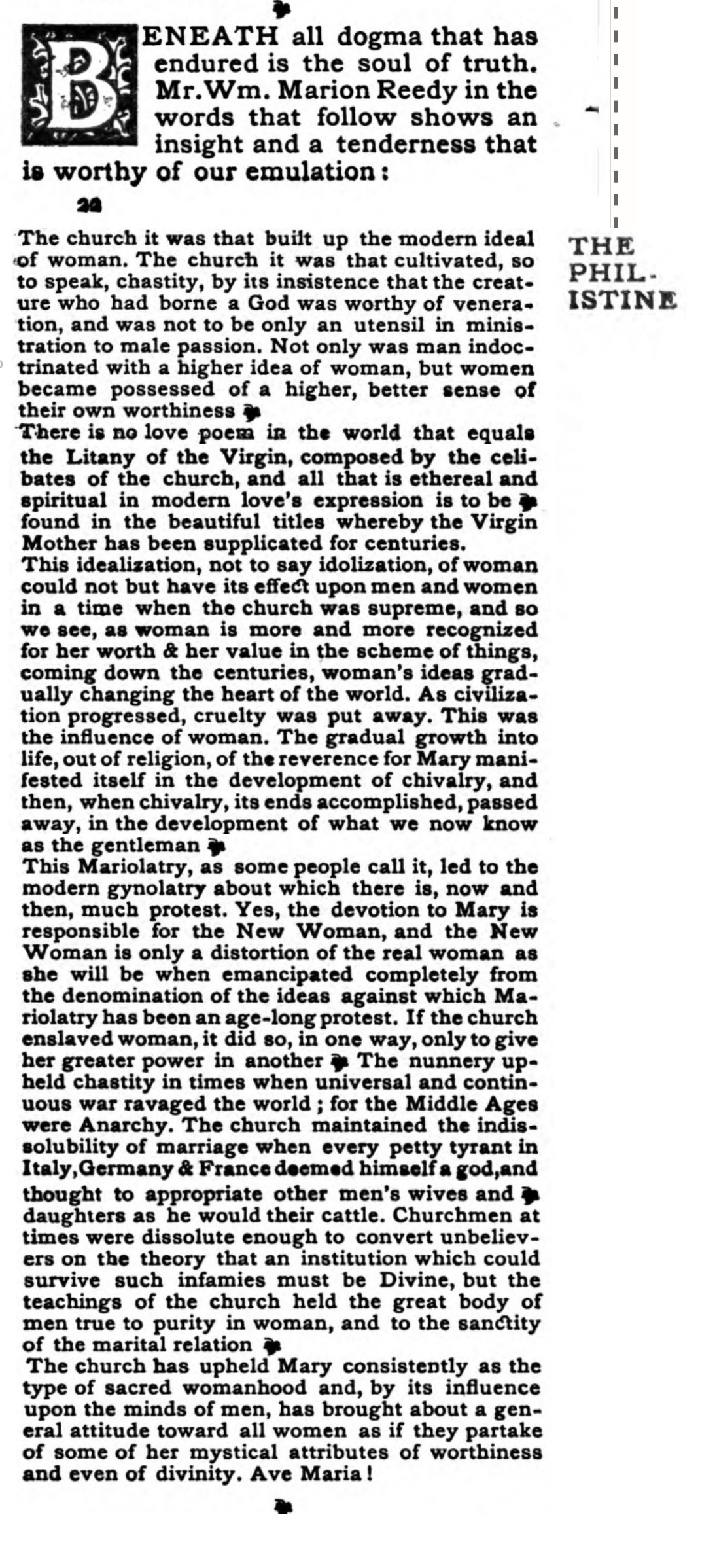
Robert Briffault’s ‘The Troubadours’: discusses Mary’s influence on women’s status (click images to enlarge)
